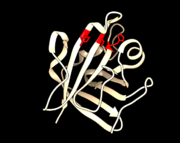Sandbox sortases
From Proteopedia
(Difference between revisions)
| Line 9: | Line 9: | ||
[[Image:1T2Pactivesite.png | thumb | PDB 1T2W Active Site Reisdues Arg 197, Cys 184, and His 120 highlighted]] | [[Image:1T2Pactivesite.png | thumb | PDB 1T2W Active Site Reisdues Arg 197, Cys 184, and His 120 highlighted]] | ||
== ''S. aureus'' SrtA mechanism == | == ''S. aureus'' SrtA mechanism == | ||
| - | In Gram-positive bacteria, SrtA enzymes are almost always present. Their prevalence, combined with them being discovered first, has led to them having the most extensive mechanistic studies of all the sortases. The active site is composed of an Arginine residue (Arg 197), a Cystine residue (Cys 184), and a Histidine residue (His 120). SrtA has a LPXTG recognition sequence that is highly conserved. Mobile loops peripheral to the active site bind to this sequence near the C-terminal. In ''S. aureus'' a calcium ion binds behind the substrate binding groove and locks the loops into a binding position. The Arg197 residue hydrogen bonds to the carbonyl on the peptide backbone of the substrate, meanwhile the Cys184 deprotonates into a thiolate ion to perform a nucleophilic attack on the bond between T and G on the substrate. The His120 residue donates a proton to the amine leaving group of the substrate’s C-terminal domain. Then an amine on the pentaglycine crossbridge protein of a peptidoglycan precursor enters the active site and has a proton abstracted by the histidine. This increases the amine’s nucleophilicity enabling a nucleophilic attack on substrate. This dislocates the substrate from the enzyme and restores the active site | + | In Gram-positive bacteria, SrtA enzymes are almost always present. Their prevalence, combined with them being discovered first, has led to them having the most extensive mechanistic studies of all the sortases. The active site is composed of an Arginine residue (Arg 197), a Cystine residue (Cys 184), and a Histidine residue (His 120). SrtA has a LPXTG recognition sequence that is highly conserved. Mobile loops peripheral to the active site bind to this sequence near the C-terminal. In ''S. aureus'' a calcium ion binds behind the substrate binding groove and locks the loops into a binding position. The Arg197 residue hydrogen bonds to the carbonyl on the peptide backbone of the substrate, meanwhile the Cys184 deprotonates into a thiolate ion to perform a nucleophilic attack on the bond between T and G on the substrate. The His120 residue donates a proton to the amine leaving group of the substrate’s C-terminal domain. Then an amine on the pentaglycine crossbridge protein of a peptidoglycan precursor enters the active site and has a proton abstracted by the histidine. This increases the amine’s nucleophilicity enabling a nucleophilic attack on the substrate. This dislocates the substrate from the enzyme and restores the active site, resulting in the two peptides bonded together. This process is entirely driven without spending ATP <ref name= "Handbook of Proteolytic Enzymes" />. |
== Sortase Classes == | == Sortase Classes == | ||
Revision as of 19:18, 11 December 2015
This page is setup for Brandon to build his senior project for OU CHEM 4923
Sortase System
| |||||||||||
References
- ↑ 1.0 1.1 1.2 1.3 1.4 1.5 McCafferty, Dewey G., and Jeffrey A. Melvin. ‘Sortases’. Handbook of Proteolytic Enzymes. N.p.: Elsevier BV, 2013. 2459–2465. PDF.
- ↑ 2.0 2.1 2.2 2.3 2.4 Spirig, T, EM Weiner, and RT Clubb. ‘Sortase Enzymes in Gram-Positive Bacteria’. Molecular microbiology. 5.82 (27 Oct. 2011): n.pag. 4 Nov. 2015.
- ↑ Maresso, Anthony W., Travis J. Chapa, and Olaf Schneewind. ‘Surface Protein IsdC and Sortase B Are Required for Heme-Iron Scavenging of Bacillus Anthracis▿’. 188.23 (29 Sep. 2006): n.pag. 4 Nov. 2015.
- ↑ Theile, Christopher S, et al. ‘Site-Specific N-Terminal Labeling of Proteins Using Sortase-Mediated Reactions’. Nature Protocols 8.9 (29 Aug. 2013): 1800–1807.
- ↑ Mao, H, et al. ‘Sortase-Mediated Protein Ligation: A New Method for Protein Engineering’. Journal of the American Chemical Society. 9.126 (5 Mar. 2004): n.pag. 4 Nov. 2015.

